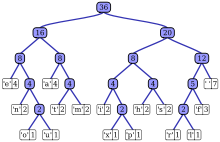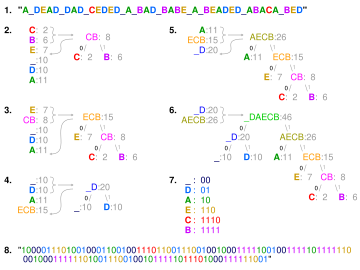In the field of data compression, Shannon–Fano coding, named after Claude Shannon and Robert Fano, is one of two related techniques for constructing a prefix code based on a set of symbols and their probabilities.

Arithmetic coding (AC) is a form of entropy encoding used in lossless data compression. Normally, a string of characters is represented using a fixed number of bits per character, as in the ASCII code. When a string is converted to arithmetic encoding, frequently used characters will be stored with fewer bits and not-so-frequently occurring characters will be stored with more bits, resulting in fewer bits used in total. Arithmetic coding differs from other forms of entropy encoding, such as Huffman coding, in that rather than separating the input into component symbols and replacing each with a code, arithmetic coding encodes the entire message into a single number, an arbitrary-precision fraction q, where 0.0 ≤ q < 1.0. It represents the current information as a range, defined by two numbers. A recent family of entropy coders called asymmetric numeral systems allows for faster implementations thanks to directly operating on a single natural number representing the current information.
A prefix code is a type of code system distinguished by its possession of the "prefix property", which requires that there is no whole code word in the system that is a prefix of any other code word in the system. It is trivially true for fixed-length code, so only a point of consideration in variable-length code.
Golomb coding is a lossless data compression method using a family of data compression codes invented by Solomon W. Golomb in the 1960s. Alphabets following a geometric distribution will have a Golomb code as an optimal prefix code, making Golomb coding highly suitable for situations in which the occurrence of small values in the input stream is significantly more likely than large values.
Truncated binary encoding is an entropy encoding typically used for uniform probability distributions with a finite alphabet. It is parameterized by an alphabet with total size of number n. It is a slightly more general form of binary encoding when n is not a power of two.

Coding theory is the study of the properties of codes and their respective fitness for specific applications. Codes are used for data compression, cryptography, error detection and correction, data transmission and data storage. Codes are studied by various scientific disciplines—such as information theory, electrical engineering, mathematics, linguistics, and computer science—for the purpose of designing efficient and reliable data transmission methods. This typically involves the removal of redundancy and the correction or detection of errors in the transmitted data.
The Lempel–Ziv–Markov chain algorithm (LZMA) is an algorithm used to perform lossless data compression. It has been under development since either 1996 or 1998 by Igor Pavlov and was first used in the 7z format of the 7-Zip archiver. This algorithm uses a dictionary compression scheme somewhat similar to the LZ77 algorithm published by Abraham Lempel and Jacob Ziv in 1977 and features a high compression ratio and a variable compression-dictionary size, while still maintaining decompression speed similar to other commonly used compression algorithms.
Prediction by partial matching (PPM) is an adaptive statistical data compression technique based on context modeling and prediction. PPM models use a set of previous symbols in the uncompressed symbol stream to predict the next symbol in the stream. PPM algorithms can also be used to cluster data into predicted groupings in cluster analysis.
In information theory, Shannon's source coding theorem establishes the statistical limits to possible data compression for data whose source is an independent identically-distributed random variable, and the operational meaning of the Shannon entropy.

In data compression, a universal code for integers is a prefix code that maps the positive integers onto binary codewords, with the additional property that whatever the true probability distribution on integers, as long as the distribution is monotonic (i.e., p(i) ≥ p(i + 1) for all positive i), the expected lengths of the codewords are within a constant factor of the expected lengths that the optimal code for that probability distribution would have assigned. A universal code is asymptotically optimal if the ratio between actual and optimal expected lengths is bounded by a function of the information entropy of the code that, in addition to being bounded, approaches 1 as entropy approaches infinity.
In computer science and information theory, a canonical Huffman code is a particular type of Huffman code with unique properties which allow it to be described in a very compact manner. Rather than storing the structure of the code tree explicitly, canonical Huffman codes are ordered in such a way that it suffices to only store the lengths of the codewords, which reduces the overhead of the codebook.
In coding theory, a variable-length code is a code which maps source symbols to a variable number of bits. The equivalent concept in computer science is bit string.
The package-merge algorithm is an O(nL)-time algorithm for finding an optimal length-limited Huffman code for a given distribution on a given alphabet of size n, where no code word is longer than L. It is a greedy algorithm, and a generalization of Huffman's original algorithm. Package-merge works by reducing the code construction problem to the binary coin collector's problem.
A locally decodable code (LDC) is an error-correcting code that allows a single bit of the original message to be decoded with high probability by only examining a small number of bits of a possibly corrupted codeword. This property could be useful, say, in a context where information is being transmitted over a noisy channel, and only a small subset of the data is required at a particular time and there is no need to decode the entire message at once. Note that locally decodable codes are not a subset of locally testable codes, though there is some overlap between the two.
In computer science and information theory, Tunstall coding is a form of entropy coding used for lossless data compression.
In computer science, an optimal binary search tree (Optimal BST), sometimes called a weight-balanced binary tree, is a binary search tree which provides the smallest possible search time (or expected search time) for a given sequence of accesses (or access probabilities). Optimal BSTs are generally divided into two types: static and dynamic.
In the field of data compression, Shannon coding, named after its creator, Claude Shannon, is a lossless data compression technique for constructing a prefix code based on a set of symbols and their probabilities. It is suboptimal in the sense that it does not achieve the lowest possible expected code word length like Huffman coding does, and never better than but sometimes equal to the Shannon–Fano coding.
Asymmetric numeral systems (ANS) is a family of entropy encoding methods introduced by Jarosław (Jarek) Duda from Jagiellonian University, used in data compression since 2014 due to improved performance compared to previous methods. ANS combines the compression ratio of arithmetic coding, with a processing cost similar to that of Huffman coding. In the tabled ANS (tANS) variant, this is achieved by constructing a finite-state machine to operate on a large alphabet without using multiplication.
The Garsia–Wachs algorithm is an efficient method for computers to construct optimal binary search trees and alphabetic Huffman codes, in linearithmic time. It is named after Adriano Garsia and Michelle L. Wachs.
Re-Pair is a grammar-based compression algorithm that, given an input text, builds a straight-line program, i.e. a context-free grammar generating a single string: the input text. In order to perform the compression in linear time, it consumes the amount of memory that is approximately five times the size of its input.





































